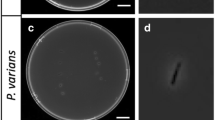Summary
The alkaline phosphatase activity of particulate matter derived from a variety of environments differing in ambient orthophosphate concentration has been examined. Orthophosphate inhibition of enzyme activity was directly related to the ambient orthophosphate concentration of the source of the particulate matter. Extracts of particulate matter from selected sites hydrolysed a range of inorganic and organic phosphates. Inhibition of phosphatase activity by cations was generally less powerful than that by anions. Of the metals likely to occur in waste waters, cadmium, nickel, zinc, and copper showed some degree of inhibition; tungstate was a strong inhibitor of all extracts. The behaviour of extracts bore a closer resemblance to that of a constitutive enzyme than to that of an inducible enzyme, but the similarity was shallow. The hydrolytic behaviour of particulate matters is likely to be influenced by many factors including the nutritional and physico-chemical status of the environment.
Similar content being viewed by others
References
Berman, T. (1969). Nature224, 1231–1232
Berman, T., Moses, G. (1972). Hydrobiologica40, 487–498
Bessey, O.A., Lowry, O.L., Brock, M.T. (1946). J. Biol. Chem.164, 321–329
Engelbercht, R.S., Morgan, J.J. (1959). Sewage Ind. Wastes,31, 458–478
Finstein, M.S., Hunter, J.V. (1967). Water Res.1, 247–254.
Flint, K.P., Hopton, J.W. (1977). Eur. J. Appl. Microbiol.3, 237–243
Flint, K.P., Hopton, J.W. (1977). Eur. J. Appl. Microbiol.4, 207–217
Jansson, M. (1976). Science194, 320–321
Jones, J.G. (1972). J. Ecol.60, 777–791
Karl-Kroupa, E., Callis, C.F., Seifter, E. (1957). Ind. Eng. Chem.49, 2061–2062
Majumdar, M.K., Majumdar, S.K. (1971). Biochem. J.122, 397–404
Murphy, J., Riley, J.P. (1962). Anal. Chem. Acta.27, 31–36
Pike, E.B., Carrington, E.G., Ashburner, P.A. (1972). J. Appl. Bacteriol.35, 309–321
Pike, E.B., Curds, C.R. (1971). In: Microbial Aspects of Pollution, G. Sykes, F.A. Skinner (eds.) London: Academic Press
Reichardt, W. (1971), Hydrobiologia,30, 377–394
Reichardt, W., Overbeck, J., Steubing, L. (1967). Nature216, 1345–1347
Sawyer, C.N. (1952). Sewage. Ind. Wastes24, 768–784
Torriani, A. (1960). Biochim. Biophys. Acta.38, 460–469
Author information
Authors and Affiliations
Rights and permissions
About this article
Cite this article
Flint, K.P., Hopton, J.W. Substrate specificity and ion inhibition of bacterial and particle associated alkaline phosphatases of waters and sewage sludges. European J. Appl Microbiol. 4, 195–204 (1977). https://doi.org/10.1007/BF01390480
Received:
Issue Date:
DOI: https://doi.org/10.1007/BF01390480



